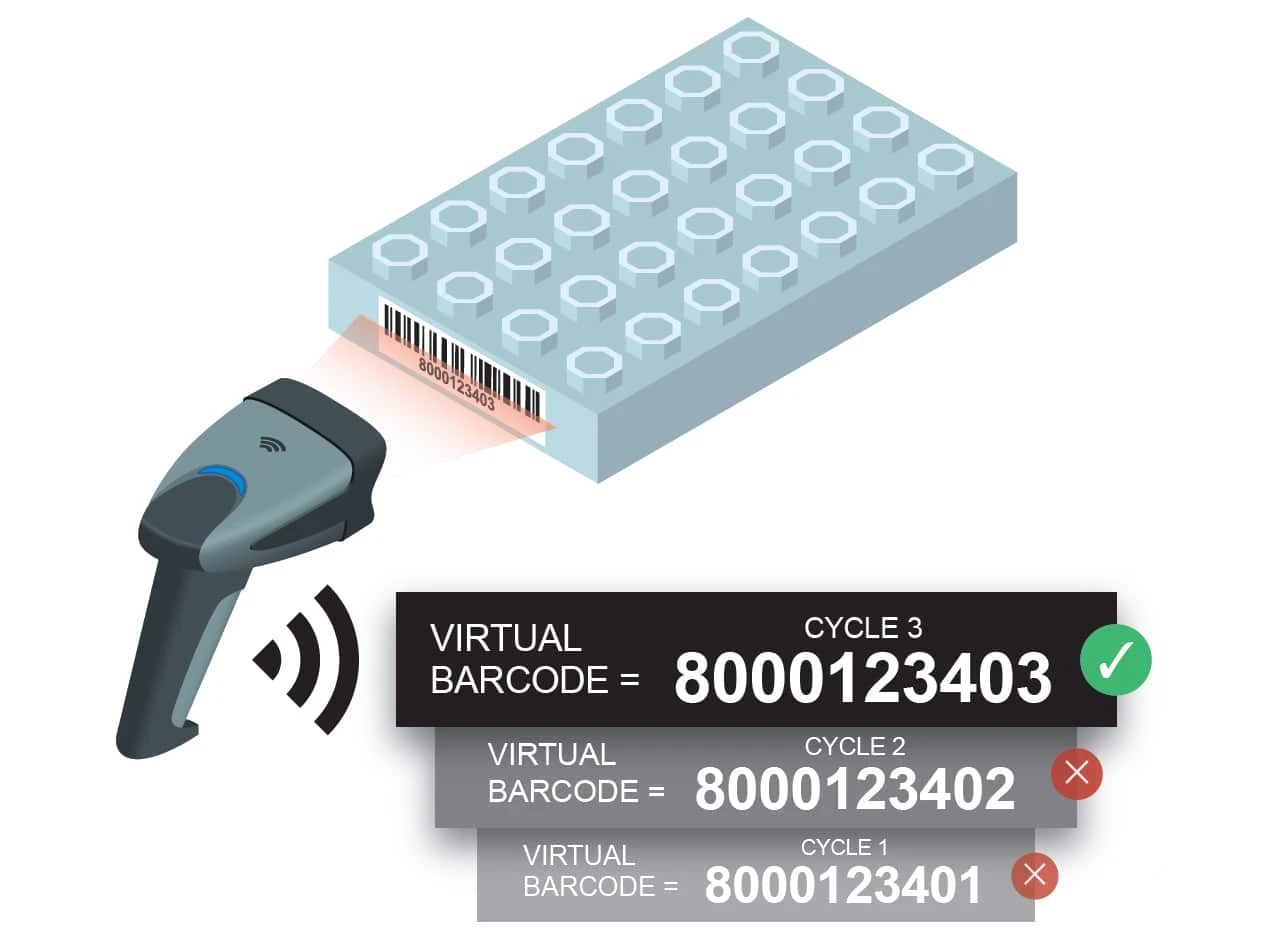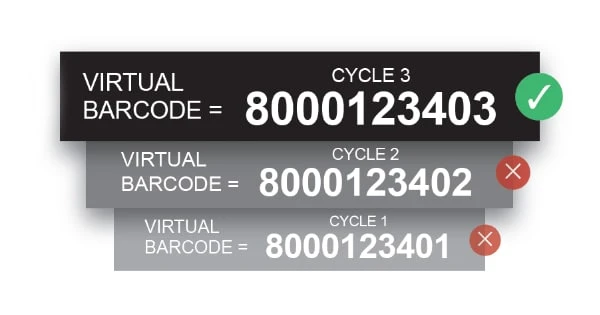Barcodes serve as essential tools for optimizing operational efficiency across diverse industries. These unique identifiers, encoding information into parallel lines, have revolutionized inventory management, asset tracking, and data collection processes. However, traditional barcode systems encounter a fundamental limitation – their inherently single-use nature.
The concept of single-use arises from the unique identification function of barcodes. Once a barcode is scanned, its utility diminishes, rendering the associated product effectively limited to a single transaction or use. This constraint presents significant challenges, particularly in industries reliant on consumable goods, where the single-use nature of barcodes can result in inefficiencies and increased costs.
For nearly five decades, Computype has spearheaded innovations in barcode solutions, creating change and enhancing the way industries track and manage their assets. Now, standing on the cusp of a new era, we introduce a groundbreaking advancement: Virtual Barcodes. This proprietary technology represents a paradigm shift in asset tracking, offering organizations unprecedented flexibility, efficiency, and accuracy in managing their physical assets.
In this article, we delve into the innovative realm of virtual barcodes, exploring how this emerging technology addresses the limitations inherent in traditional barcode systems. We invite you to explore the limitless possibilities it offers for revolutionizing asset management practices. From durable barcode labeling solutions to advanced tracking software, each component of the virtual barcode ecosystem plays a crucial role in unlocking new efficiencies and driving organizational success.
What is a virtual barcode?
A virtual barcode is a digital representation of a unique physical identifier, offering a sophisticated solution to the limitations inherent in traditional barcode systems. Unlike physical barcodes, which are static and tied to a single use, virtual barcodes possess dynamic capabilities, enabling them to adapt and evolve over time.
At its core, a virtual barcode functions as a digital stand-in for a physical asset’s unique identifier. A single product may accumulate hundreds of virtual barcodes throughout its lifecycle, each representing a distinct cycle of usage. However, the product retains only one physical barcode and numeric ID, which serve as immutable identifiers for the physical product. When a product enters a new cycle, a new virtual barcode is generated, associated with the same physical barcode.
Virtual barcodes are transient markers, with each new cycle receiving a new virtual barcode. This distinction ensures clarity and continuity in asset tracking, even as products undergo multiple iterations of use.
For instance, let’s consider a storage box with the numeric identifier “80001234.” Upon its introduction into the system, it is assigned a virtual barcode, such as “8000123401,” marking the commencement of its first cycle. Throughout this cycle, the box is utilized, moved, and its activity meticulously tracked under the umbrella of the virtual barcode “8000123401.” Subsequent cycles usher in new virtual barcodes, such as “8000123402” and beyond, each encapsulating a discrete phase of the asset’s usage.
The beauty of virtual barcodes lies in their ability to facilitate asset reuse while preserving comprehensive historical tracking. Despite transitioning through multiple cycles, the physical asset remains unchanged, identified by its enduring physical barcode. Meanwhile, the virtual barcodes meticulously capture each cycle’s activity, ensuring data integrity and streamlined asset management.
Implementing a virtual barcode solution.
Implementing a virtual barcode solution requires a cohesive integration of hardware, software, and operational protocols. At the hardware level, traditional barcode scanners and printers remain important components, facilitating the initial identification and labeling of physical assets. These physical barcodes serve as the foundation upon which virtual barcodes are built, establishing a tangible link between the digital and physical realms.
While some adhesive barcode labels can withstand multiple years of use, certain applications may require a more permanent solution. In such cases, advanced barcoding and marking technologies offer innovative solutions to ensure the longevity and permanence of barcode labels. Techniques such as cured inks, ceramic bonding, laser etching, and other cutting-edge methods enable the direct marking of barcodes onto the surface of the product itself, eliminating the risk of label degradation or detachment over time.
Once the physical barcode is applied, the software will facilitate the check-in process and initiate the virtual barcode cycles.
Explaining Virtual Barcode Cycles
Virtual barcode cycles are distinct phases of usage that allow for comprehensive tracking and management of physical assets over time. When a product is initially entered into the system, the user sets the maximum number of cycles it can undergo. For example, if a physical asset is designated for reuse 100 times, this limit is established within the tracking software.
Throughout its lifecycle, the product progresses through multiple cycles, each represented by a unique virtual barcode. As the product moves from one cycle to the next, the tracking software monitors the cycle count. When a cycle reaches its designated limit, typically set by the user upon initial entry, the software deactivates the product, ensuring that it is not reused beyond its predetermined threshold.
For instance, if the previous cycle reached cycle 100, indicating the maximum allowed usage, the software will deactivate the product and refrain from generating a new virtual barcode for subsequent cycles. Conversely, if the cycle count is below the maximum limit, the software generates a new virtual barcode to initiate the next cycle of usage.
By implementing this cycle-based approach, organizations can effectively manage the lifespan of their physical assets, ensuring optimal utilization while maintaining adherence to predefined usage limits. This proactive approach enhances efficiency, minimizes operational risks, and promotes sustainable asset management practices.

How to manage virtual barcodes with asset tracking software.
Managing virtual barcodes with asset tracking software is essential for ensuring seamless integration, accurate data capture, and efficient asset management processes. Powered by atma.io by Avery Dennison, specialized tracking software, such as our LabTrack™ Software, provides organizations with the tools and capabilities to maximize the potential of virtual barcodes in their asset management workflows.
At its core, the tracking software offers comprehensive functionality to track item stock, monitor shipping logistics, manage storage conditions, document item history, and much more. This end-to-end visibility enables organizations to gain precise insights into their inventory, facilitating informed decision-making and proactive resource allocation.
Upon scanning a virtual barcode, users gain instant access to a wealth of information pertaining to the associated asset, including its history, current status, and relevant metadata. The software platform provides real-time information on the product’s current location, ensuring that users can monitor its movement and status at any given time. This visibility extends to the product’s history of movement, enabling users to track its journey through various workflows, locations, and interactions.
A key feature of our software is its ability to reconcile digital and physical barcodes seamlessly, mitigating the risk of confusion or discrepancies. Through advanced algorithms and intuitive user interfaces, users can effortlessly navigate between digital records and physical assets, ensuring accuracy and reliability in asset tracking processes.
Moreover, the tracking software serves as a centralized hub of data, seamlessly integrating with users’ existing platforms to ensure a cohesive and synchronized approach to asset management. By consolidating data from various sources into a unified interface, the software eliminates silos and streamlines operations, enhancing efficiency and productivity across the organization.
In essence, the successful implementation of a virtual barcode solution hinges on the seamless integration of hardware and software components, supported by robust operational protocols. By leveraging the combined power of physical and virtual barcodes, organizations can revolutionize their asset management practices, driving efficiency, transparency, and innovation across their operations.
Moreover, the tracking software serves as a centralized hub of data, seamlessly integrating with users’ existing platforms to ensure a cohesive and synchronized approach to asset management. By consolidating data from various sources into a unified interface, the software eliminates silos and streamlines operations, enhancing efficiency and productivity across the entire organization.
In essence, the successful implementation of a virtual barcode solution hinges on the seamless integration of hardware and software components, supported by robust operational protocols.
By leveraging the combined power of physical and virtual barcodes, organizations can revolutionize their asset management practices, driving efficiency, transparency, and innovation across their operations.
In conclusion, the advent of virtual barcode technology marks a pivotal moment in the evolution of asset management. By transcending the limitations of traditional barcodes, virtual barcodes offer organizations unparalleled flexibility, efficiency, and accuracy in tracking their physical assets. With the seamless integration of durable barcode labeling solutions and advanced tracking software, powered by platforms like atma.io by Avery Dennison, organizations can unlock new levels of visibility, control, and productivity.
Furthermore, virtual barcodes play a crucial role in supporting sustainability efforts by enabling the reuse of traditionally single-use items without compromising data and tracking capabilities. This innovative approach not only streamlines asset management processes but also contributes to reducing waste and environmental impact.
As industries continue to embrace the potential of virtual barcodes, we envision a future where asset management practices are streamlined, transparent, and data-driven. By harnessing the power of innovative technologies and leveraging the expertise of industry leaders like Computype, organizations can embark on a journey towards operational excellence and sustained competitive advantage.
At Computype, we remain committed to pushing the boundaries of innovation and empowering our customers to thrive in an increasingly complex business environment. With Virtual Barcodes, the possibilities are limitless. Join us as we pave the way for a new era of asset management excellence, one barcode at a time.

